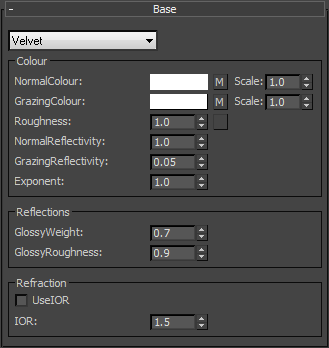
Documentation

Documentation
Backscatter refers to the reflection of light back in the direction it originated from. Backscatter is useful for representing materials that have a 'pile' such as velvet and suede.
The backscattering component is a combination of two reflectance functions: a backscatter function where rays of light get reflected back toward the light source, and a standard glossy function where light is bounced off at the angle of incidence. The combination of these is controlled by the GlossyWeight parameter; setting 0.0 for this results in pure backscattering.

The color when looking directly down onto the surface of an object.
Input: Map/Color
The color when looking at the 90˚ edge of an object.
Input: Map/Color
Higher values result in blurrier reflections.
Range: 0.0 - 1.0 or Map
Click material thumbnail for larger view
How shiny the object appears looking straight on.
Range: 0.0 - 1.0
Click material thumbnail for larger view
How shiny the object appears looking at a very shallow angle.
Range: 0.0 - 1.0
Click material thumbnail for larger view
Controls how quickly the shininess changes between the normal and grazing values as you move across the surface.
Range: 0.01 - 25
Click material thumbnail for larger view
How much of the material should be made up of the Glossy function. Set this at 0.0 for pure backscattering.
Range: 0.0 - 1.0
Click material thumbnail for larger view
Simulates the level of polish in the glossy part of the material. Higher values result in blurrier reflections.
Range: 0.0 - 1.0
Click material thumbnail for larger view
Ignores the normal and grazing values and exponent, and uses the "IOR" parameter to define the falloff curve.
Index of Refraction. Controls the amount of reflection and shape of the falloff curve, Use IOR must be checked.
Range: 0.0 -
Click material thumbnail for larger view
Base
Click material thumbnail for larger view
▲Page Last Edited: